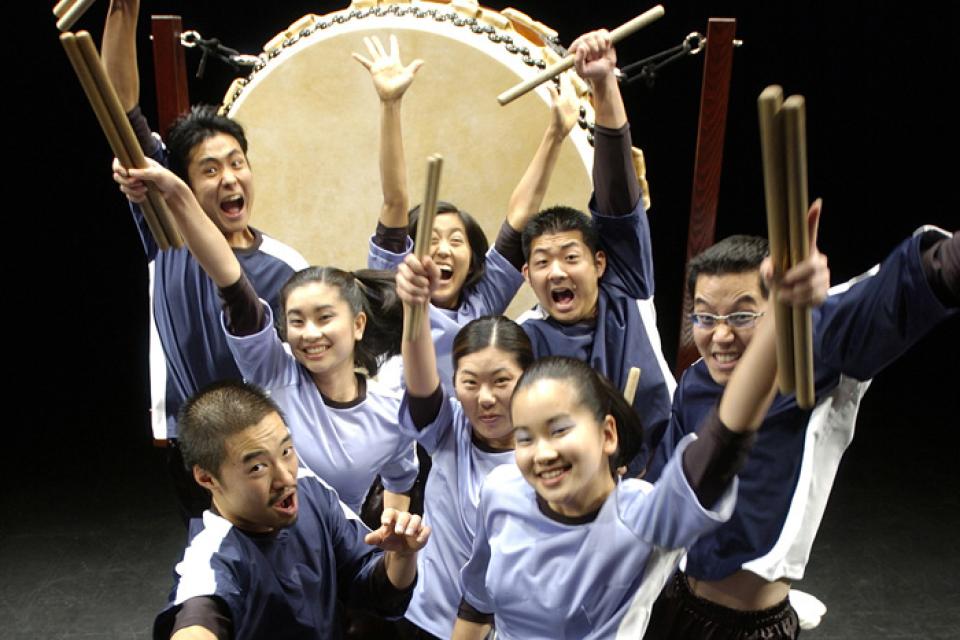
Big Drum Articles—TAIKOPROJECT
TAIKOPROJECT: Not Your Mama’s Taiko
This isn’t your mama’s taiko, but it may be your hip younger cousin’s.
—LA Weekly
The flashy appearance of sexily-clad female taiko players in national TV commercials for Mitsubishi Motors created a stir that people are still talking about.
Backed by elaborate pyrotechnics, the young performers beat drums in a frenzy of thunderous sound and motion. The recent TV spots, which have been described by automotive journalists as “compelling” and “catchy,” were reportedly ranked among the mostly highly popular ads of the season by ad industry critics. Bryan Yamami, artistic director for TAIKOPROJECT, coordinated the selection and training of the taiko players in the Mitsubishi Eclipse commercial that included members of TAIKOPROJECT, UCLA Kyodo Taiko, and Venice Koshin Taiko.

The TAIKOPROJECT, founded in 2000, is an ensemble of taiko drummers drawn from groups across North America. The group is dedicated to promoting American taiko through educational activities and public performances. Fusing tradition with edgy and sometimes daring contemporary elements, the ensemble is among the fast-rising stars of taiko.
TAIKOPROJECT’s first creative effort, entitled (re)generation, is a “state-of-the-art” theatrical production that blends taiko with storytelling, spoken word, music, hip hop choreography, and dance. Employing multiple media, the production (available on DVD) showcases the dynamic talents and sensuous, physical power of taiko drumming and also takes the audience behind the scenes to learn about what taiko means to the performers. In addition, it shares the colorful historical journey taiko has taken in the United States. The original members include those who have trained with various pioneering taiko groups—San Jose, San Francisco Taiko Dojo, Kinnara Taiko, and Shasta Taiko—often from very young ages. While defining a new style and generation of players, they also acknowledge the work and legacy of those who had trained them.

“I think for me one of the most important things about taiko is that no matter why you play or the reasons that you have for playing, it’s valid,” says Bryan Yamami. “Having seen taiko all over the place, from Hawaii to New York and all through Canada, it’s just great to see—and kind of amazing how much people have just taken this drum and incorporated a million different things with it.”
Performer Michelle Fujii, an original member of TAIKOPROJECT and now with On Ensemble, earns a living as a full-time taiko artist. She explains that one of the most dramatic variables of a taiko performance is movement.
“We always talk about taiko as part music, part dance,” Fujii says. “I love that. That’s actually why I started, because it was so empowering to play. I get to move around it. I started to build this passion, this incredible passion for what dance is—especially folk dance and its relationship to taiko because I think there are lots of different commonalities. Taiko can become an entire picture with sound.”
Although some of the original members have since moved on to other projects, they continue to move taiko into different directions. For them, encouraging creative freedom is a strongly recurring theme.

“My vision for taiko is to have it grow—and to let go of it to allow it to grow,” says Shoji Kameda, a 28-year-old Northern California native who started playing taiko at the age of eight. He is now the artistic director of On Ensemble and a member of the band Hiroshima. “I think as taiko grows and expands out of the Asian American community, as it expands out of the Japanese American community, there’s going to be some uneasiness because it was so important as a way of establishing our cultural identity. But I really feel like we have to let control go. We have to be okay with these groups that have no idea what they’re doing and are in the middle of nowhere and just banging drums. That has to be okay because I think the history of taiko will be inextricably bound to the history of Asian American and the Japanese American. No one can ever take that away.”
This interview was conducted in conjunction with the Big Drum: Taiko in the United States exhibition in 2005.
